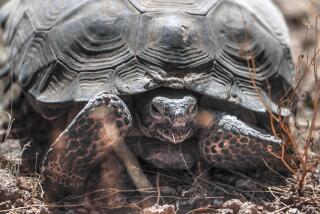Tortoise Needs Space if Base Grows, Panel Says
- Share via
If the Army is allowed to add 182 square miles to its sprawling National Training Center at Ft. Irwin, more than 2,000 square miles of the Mojave Desert should be reserved as the exclusive domain of the desert tortoise, a panel of environmental experts has grudgingly recommended.
Such a reserve, including private holdings and public land now used by desert recreation enthusiasts, would cost more than $400 million to acquire, develop and manage, the panel says in a report now being reviewed by the Interior Department in Washington.
The panel, which the Army asked to determine the best way to offset the loss of tortoise habitat, said it would prefer that no expansion occur. But if the expansion must take place, the panel added, the reserve should be established to help replace the loss.
Dissidents on the panel said even that would not suffice to ensure the future of the threatened tortoise. The Army had no immediate comment on the report, released Friday.
The report is the latest salvo in the ongoing battle between tanks and tortoises in the desert around Barstow. The military says it needs to expand Ft. Irwin, already the largest Army training center in the nation, to accommodate battlefield exercises that incorporate a new generation of weapons and tactics. Environmentalists counter that nowhere in California does the desert tortoise thrive better than on the land coveted by tank commanders.
The panel, made up of environmental experts from various state and federal agencies and universities, was formed under the auspices of the U.S. Bureau of Land Management. It concluded that survival of the region’s tortoise population is in greater jeopardy than ever. Loss of the 182 square miles to the south and west of Ft. Irwin would further jeopardize the species’ existence in the western Mojave, the panel said, because the land is relatively untouched and is home to the desert’s most healthy tortoises.
The Army most recently sought to expand to the east of the training center, where the impact on tortoises was believed to be less. But because of widespread opposition to that proposal from recreation users and others, the Army focused on the land on the southwest, which it preferred for logistical reasons.
The best that could be done to partly offset the loss of habitat, the panel said, would be to set aside a 1.4-million-acre reserve in the high desert--more than 10 times larger than the land sought by the Army--and to prohibit virtually all future development, including a proposed Lockheed rocket-launch facility. Also banned would be grazing for sheep and cattle, prospecting and most recreational uses, including off-road activities, hiking and rock collecting.
Much of the proposed reserve is already earmarked as critical tortoise habitat, but the various government agencies that control it have not implemented previous recommendations by environmentalists to protect it. Because of that, the panel unanimously agreed that the plight of the tortoise is worsening.
Capturing tortoises that now burrow on the land sought by Ft. Irwin and relocating them to the reserve is not a plausible solution, the panel said. Tortoise relocation is still considered an experiment with no proven track record of success, the panel said.
Three of the 12 panel members were so opposed to the Army’s expansion plans that they refused to sign off on the panel’s report.
One of the three, Raymond Bransfield of the U.S. Fish and Wildlife Service, said the panel had no evidence that establishing a reserve would benefit the tortoises, especially because a growing number of them already in areas designated for the reserve are succumbing to a disease of the upper respiratory tract and other maladies. Maintaining the existing habitat is “the best way to ensure that the species will survive,” he said.
Among the critical issues in establishing a reserve is the cost, including about $300 million to buy 460,000 acres of private land within the reserve. Other costs include $11 million to restore off-road-vehicle routes, $24 million to pay for two rangers to patrol the preserve for the next 30 years, $8.5 million for fences, $10 million for tortoise relocation and $5 million to buy back livestock-grazing and mineral rights.
A spokesman for the Center for Biological Diversity, a wildlife advocacy group, said the proposed mitigation was “totally unacceptable” because nothing could replace the habitat sought by the Army.
The report will play a role in the “delicate negotiations” going on between the Interior Department and Army over the base expansion, said Mike Gauldin, spokesman for Interior Secretary Bruce Babbitt. “The report is very comprehensive,” Gauldin said. “. . . The panel did a good job, and it made some tough recommendations. We’re working our way through them now to determine which ones should be implemented.”
More to Read
Sign up for Essential California
The most important California stories and recommendations in your inbox every morning.
You may occasionally receive promotional content from the Los Angeles Times.










